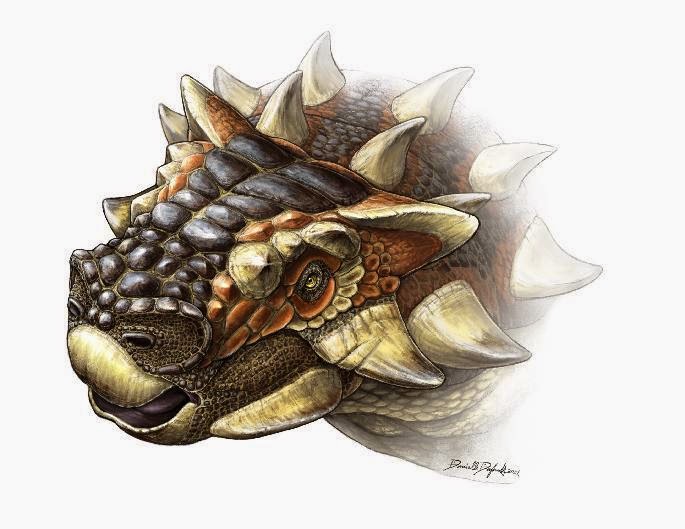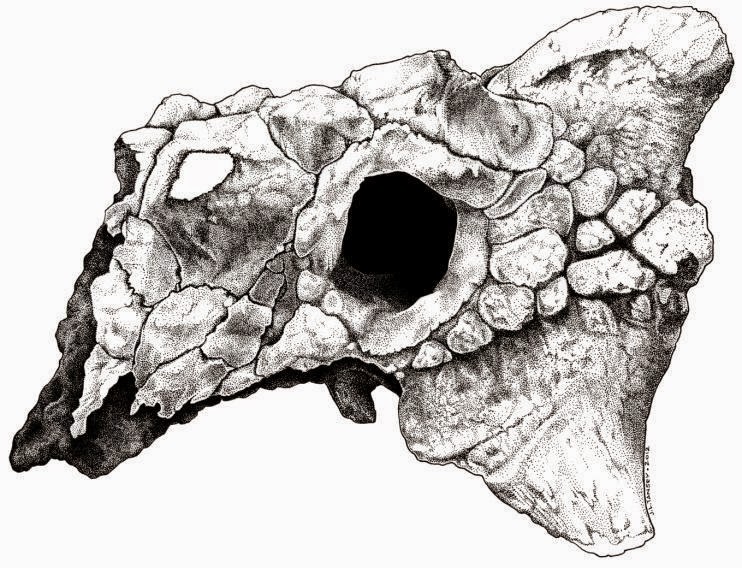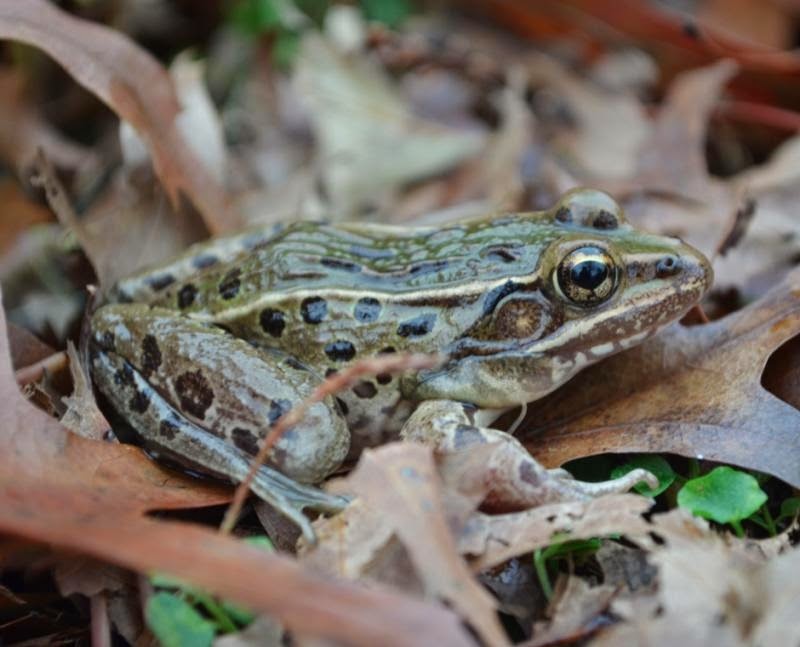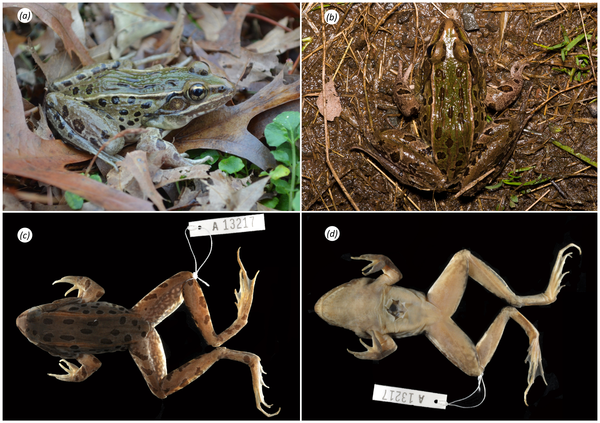[Most Recent Entries] [Calendar View]
Wednesday, October 29th, 2014
| Time | Event | ||||
| 9:42a | [Paleontology • 2014] Zaraapelta nomadis • The Ankylosaurid Dinosaurs of the Upper Cretaceous Baruungoyot and Nemegt formations of Mongolia
Abstract The discovery of a new ankylosaurid skull with some unusual features from the Baruungoyot Formation of Mongolia prompted a systematic review of ankylosaurid specimens from the Baruungoyot and Nemegt formations. Dyoplosaurus giganteus was found to possess no diagnostic features and is regarded as a nomen dubium. The holotype of Tarchia kielanae (previously synonymized with Tarchia gigantea) has one autapomorphy, an accessory postorbital ossification with surrounding furrow, and Tar. kielanae is here considered a valid species, making the combination Tar. gigantea unnecessary. An accessory postorbital ossification is also found in the holotype of Minotaurasaurus ramachandrani, and this species is here considered a junior synonym of Tar. kielanae. The newly described skull from the Baruungoyot Formation forms the holotype of a new genus and species, Zaraapelta nomadis gen. et sp. nov., diagnosed by unusual bilayered ornamentation on the squamosal horn and extensive postocular ornamentation. Two distinct tail club handle morphotypes are present in the Nemegt Formation and probably represent two different species. However, it is impossible to assign either tail club morphotype to the single valid species from the formation, Saichania chulsanensis, because of a lack of overlapping material. A revised phylogenetic analysis including newly identified characters found Zaraapelta nomadis to be most closely related to Tar. kielanae. Keywords: Ankylosauria; Ankylosauridae; Campanian; Dinosauria; Gobi Desert; Maastrichtian
Zaraapelta nomadis gen. et sp. nov. Holotype: MPC D100/1338, a partial skull missing the rostrum. Etymology: Zaraapelta nomadis; зараа (Mongolian) hedgehog, in reference to the spiky appearance of the skull, and pelta (Latin), a small shield, in reference to the osteoderms found on all ankylosaurs; nomadis, from nomas (Latin), nomad, in reference to Mongolian travel company Nomadic Expeditions, which has facilitated many years of palaeontological fieldwork in the Gobi Desert. Holotype locality and horizon: 43°28.345′N, 99°51.032′E (WGS 84), Hermiin Tsav, Gobi Desert, Mongolia; Baruungoyot Formation (Mid−Upper Campanian, Jerzykiewicz, 2000). Diagnosis: Ankylosaurine ankylosaurid with bulbous cranial ornamentation. Unlike other ankylosaurs, squamosal horn has unique smooth-textured keel offset from the rest of the squamosal horn by a distinct and abrupt change to a granular texture; elaborate pattern of postocular caputegulae covering entire postocular region between squamosal and quadratojugal horns, with more postocular caputegulae than Ano. lambei, Sa. chulsanensis, or Tar. kielanae. Victoria M. Arbour, Philip J. Currie and Demchig Badamgarav. 2014. The Ankylosaurid Dinosaurs of the Upper Cretaceous Baruungoyot and Nemegt formations of Mongolia. Zoological Journal of the Linnean Society. Mongolian armoured dinosaur with spiky helmet shows Gobi Desert was hotspot for ankylosaur diversity. | ||||
| 7:18p | [Herpetology • 2014] Rana kauffeldi | Atlantic Coast Leopard Frog • Cryptic Diversity in Metropolis: Confirmation of a New Leopard Frog Species (Anura: Ranidae) from New York City and Surrounding Atlantic Coast Regions
Abstract We describe a new cryptic species of leopard frog from the New York City metropolitan area and surrounding coastal regions. This species is morphologically similar to two largely parapatric eastern congeners, Rana sphenocephala and R. pipiens. We primarily use bioacoustic and molecular data to characterize the new species, but also examine other lines of evidence. This discovery is unexpected in one of the largest and most densely populated urban parts of the world. It also demonstrates that new vertebrate species can still be found periodically even in well-studied locales rarely associated with undocumented biodiversity. The new species typically occurs in expansive open-canopied wetlands interspersed with upland patches, but centuries of loss and impact to these habitats give some cause for conservation concern. Other concerns include regional extirpations, fragmented extant populations, and a restricted overall geographic distribution. We assign a type locality within New York City and report a narrow and largely coastal lowland distribution from central Connecticut to northern New Jersey (based on genetic data) and south to North Carolina (based on call data).
Diagnosis and Description Rana kauffeldi sp. nov. urn:lsid:zoobank.org:act:149ED690-FA7D-42 Holotype: YPM 13217, adult male (Fig. 2, Table 1), collected from Bloomfield region, Richmond County (Staten Island), NY, United States, on 15 November 2011, by B. R. Curry. Etymology: The specific epithet is a patronym in recognition of Carl F. Kauffeld who studied the R. pipiens complex in the NY/NJ-metro area and concluded that three distinct species, including an undocumented central species, occurred there. Common Name: We propose the common name ‘Atlantic Coast Leopard Frog’ for this species. Jeremy A. Feinberg, Catherine E. Newman, Gregory J. Watkins-Colwell, Matthew D. Schlesinger, Brian Zarate, Brian R. Curry, H. Bradley Shaffer and Joanna Burger. 2014. Cryptic Diversity in Metropolis: Confirmation of a New Leopard Frog Species (Anura: Ranidae) from New York City and Surrounding Atlantic Coast Regions. PLoS ONE, 2014; 9 (10): e108213 DOI: dx.doi.org/10.1371/journal.pone.0108213 |
| << Previous Day |
2014/10/29 [Calendar] |
Next Day >> |




